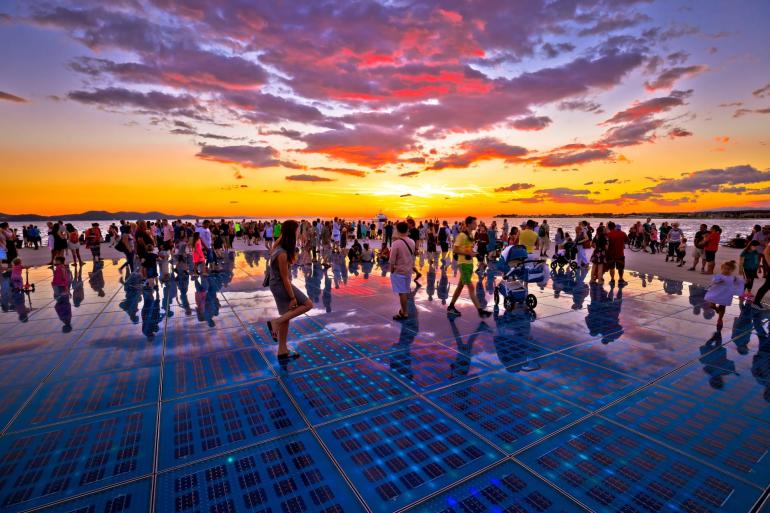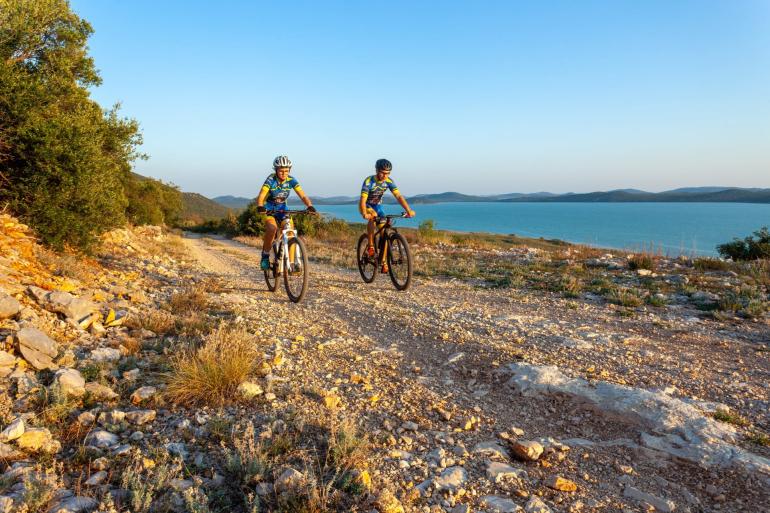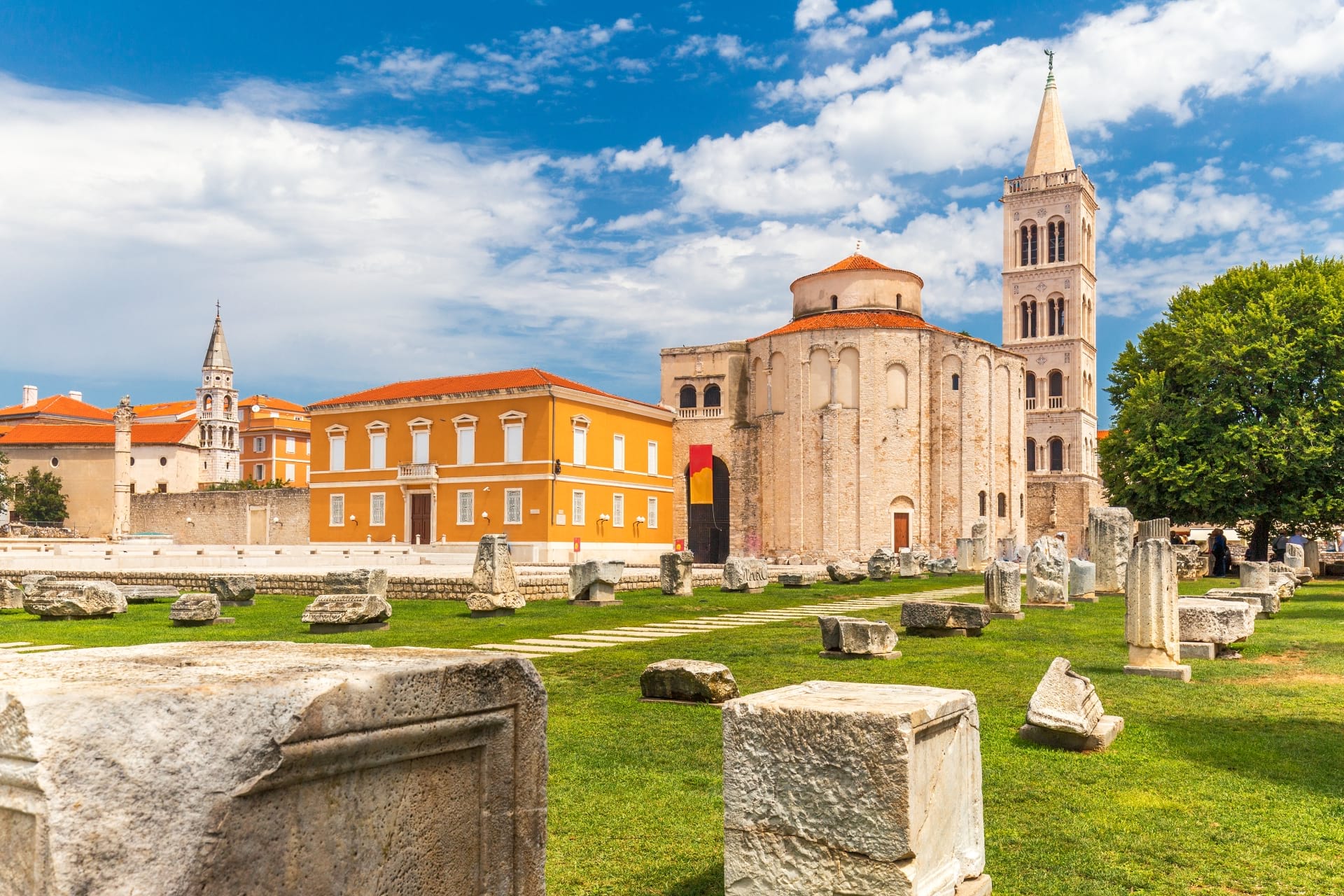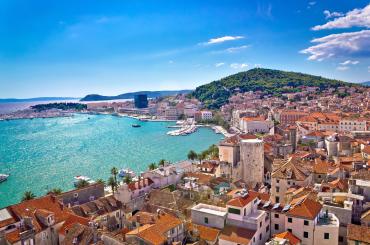For centuries, Zadar has been Dalmatia's most important city. The island of Pag is famous for its nightlife and its premium cheese. Dugi otok (Long Island), Ugljan and Pašman are large island oases brimming with hidden corners to explore, while the small islands surrounding Zadar provide the perfect opportunity for a quiet holiday away from the crowded mainland during the summer months. Make sure you visit the Kornati National Park, the most beautiful archipelago in the Adriatic Sea, comprising more than a hundred large and small islands.
Explore the rural life of the region in Benkovac and awaken your inner romantic with a visit to the small town of Nin.
Zadar - almost 3000 years of history
The Zadar Forum, a vast sun-soaked square, is the most beautiful location for observing the city life. The locals say hello to their acquaintances, the visitors admire the majestic buildings and all of them are sitting in the sun, happy that they've seized some time for a relaxing break. And once you immerse yourself in the life of this city, you will be doing the same as any traveller visiting Zadar a couple of thousand years ago.
The Church of St. Donatus, a representative bishop's chapel dating back to the 8th century, is one of the few circular medieval churches in Europe with a concentric layout
Zadar has been a city for the past 2,000 years and was settled since 9 century BC. It has always been one of the most prominent cities on the east Adriatic coast. First of all, it had one of the safest ports on the main European maritime route towards the eastern Mediterranean, which passed between the Croatian islands because the flat Italian coast offered little protection. Also, Zadar itself was one of the safest cities in the Adriatic, situated on a peninsula, surrounded by walls and protected by a moat on the mainland. It was the perfect location for a trading oasis.
 Photo: Brch
Photo: BrchZadar is famous for its sunsets. Many tourists visits this solar powered installationon "Greetings to the sun" and enjoy the view
Zadar's historic strength is visible at every corner. The Zadar Forum, the central square of an ancient Roman city, is the largest on the east Adriatic coast. The Church of St. Donatus, a representative bishop's chapel dating back to the 8th century, is one of the few circular medieval churches in Europe with a concentric layout, while the cathedral and numerous other churches with their treasures of art showcase the wealth of the city. As you walk through the ancient streets, look up and you'll be in awe by the opulent Gothic-and Renaissance-style windows.
Pag Island looks like an uninhabitable rocky desert because every morsel of soil has been whisked away by the “bura“, a forceful north-east wind
What else does Zadar have to offer? The nightlife begins in the medieval streets of Varoš, a neighbourhood in the south-east part of the city centre. Daily life begins in the picturesque fish and farmer's market, where you can buy homegrown produce every day. No matter what time it is, you can always sit next to the Sea Organ, a one-of-a-kind instrument embedded in the waterfront, and listen to the music created by the waves. With the myriad attractions in the city, Zadar is also the perfect base for exploring the surrounding area – either by sea or on land.
Pag, the moonlike island
The northern tip of Pag Island is a long and narrow peninsula lined with a beautiful road towards the village of Lun. The road is completely straight but rises and falls in sync with the uneven terrain, and offers a stunning view on both sides, one of the open sea and the other of Mount Velebit and the Velebit channel. Everywhere, you will find Lun olive groves with some 80,000 trees. Especially valuable are the 1500 or so thousand-year-old olive trees that were planted here when Europe was still young. Stop your car and take a walk among these oldtimers.
 Photo: Ygor
Photo: YgorOld olive field on the Pag Island. Among some 80,000 trees are a few that are over 1500 years old
From the mainland, Pag Island looks like an uninhabitable rocky desert because every morsel of soil has been whisked away by the “bura“, a forceful north-east wind from the mountains, so all you can see are a few green patches. The other side of Pag reveals abundance: the best sheep's cheese, the most delectable lamb, renowned saltworks and the ancient Lun olives.
Pag also has a vibrant nightlife – which is why it has been dubbed “the Croatian Ibiza“. The hub of the island's nightlife is Zrće beach, where the party never stops and which regularly hosts performances by the most revered names of the global EDM scene.
Pag's most valuable financial resource throughout history was its saltworks, which has been bringing in huge revenue for its owners since the ancient Roman period
Pag cheese and lamb have a unique flavour due to the austere vegetation of the island – the fragrant Mediterranean plants and the salt brought by the “bura“ give the milk and meat its distinctive aroma. Still, the period of vegetation growth on Pag Island is short and lasts from spring to early summer, which means that the original Pag cheese is scarce because all it takes for it to lose its authenticity is to bring the hay from somewhere else. This is why it is a highly sought after delicacy.
If you happen to find yourself in Pag or Zadar during the period of cheese production, make sure you ask about the by-product, Pag sheep “puina“, an albumin or whey cheese similar to ricotta.
Like all the other types of lamb in Croatia, Pag lamb is mostly spit-roasted.
 Photo: Goran Safarek
Photo: Goran SafarekCycling in the Lake Vrana Nature Park provides a perfect way to experience the protected ornithological park
Pag's most valuable financial resource throughout history was its saltworks, which has been bringing in huge revenue for its owners since the ancient Roman period. The saltworks is still operational today, which means that you can return from your trip to Pag with a very practical souvenir.
The islands of Ugljan and Pašman
Ugljan and Pašman are among the most accessible islands in Croatia: it only takes a 20-minute ferry ride from Zadar or Biograd na Moru to reach them and since they are connected by a bridge, there are plenty of hidden corners to explore on these two large islands. One of Ugljan's most interesting attractions is St. Michael's Fortress, which offers a view of all the surrounding islands as well as Mount Velebit deep in the hinterland. There are beautiful, mostly sandy, beaches and fishing villages hiding in the deep coves.
St. Michael's Fortress is easily accessible by car or on foot because a 5 km long paved road leads from the fortress through the fertile fields on the mainland to Preko (literally meaning “across“), a municipality that got its name for being situated opposite Zadar. In Muline at the far end of the island, you can find remnants of a Roman villa – an estate with large olive plantations, if the huge earthenware oil pots are anything to go by. Some of the boats departing for Preko call at Ošljak, an islet bereft of cars where you can find secluded beaches without many people.
The Telašćica Nature Park, located in a deep cove on the south side, is bursting with marine life and has a fascinating saltwater lake
Pašman and Ugljan used to be separated only by a stretch of shallow water that you could wade through. However, a channel was dug in the late 19th century, which significantly shortened the maritime routes towards Zadar. Pašman offers an abundance of walking and bike trails and the side facing the Kornati Islands is especially interesting. One of the most prominent outdoor activities in Croatia is “škraping“, an interesting trekking race traversing the rocky terrain of Pašman.
Dugi otok, home to gorgeous sany beach Sakarun
Two of the most popular attractions on Dugi Otok are located at opposite ends of this 45 km long island. Sakarun (or Saharun), a gorgeous sandy beach that is regularly placed on lists of Europe's most beautiful swimming spots, is located on the north side. The Telašćica Nature Park, located in a deep cove on the south side, is bursting with marine life and has a fascinating saltwater lake.
 Photo: Brch
Photo: BrchTurquoise waterfront of Ugljan island and a view of the town of Kali
Another fascinating beach is located at the very north of the island: Veli Rat, a pebble cove near the stunning 42 m high lighthouse of the same name, the tallest on the entire Adriatic coast.
On the island of Silba, the residents would elect a “king“, who ruled for 12 days
There are a few small towns with a significant population: Soline is nearest to Sakarun, Božava is a large tourist centre and Sali, which is famous for its fish factory, is the main entrance point to Telašćica for everyone staying on the island. However, the best way to explore the coves of Dugi Otok is by boat, or at least by kayak. Some of the places located on the outer part of the island can only be accessed by boat, such as Tigrovo oko (“Eye of the Tiger“), a deep hole by the coast with a colour reminiscent of a tiger’s eye, and the Golubinka cave and the erstwhile military tunnel used for hiding submarines.
The small islands surrounding Zadar
For centuries, the residents of Silba have rented their small island from its owners, who found it extremely impractical to collect the rent due to the significant distance. However, the people of Silba eventually bought the island for themselves in the early 19th century after a row and a lengthy lawsuit against one of the owners. The society on the island of Silba used to be organised in a very interesting way: every year around Christmas the residents of Silba would elect a “king“, who ruled for 12 days, the same “days of Christmas” as in the famous carol, during which he was required to establish the budget, clear the docket and form an executive government that would be in charge of the island for the entire year.
Silba hadn't seen a king for a very long time, however, this custom was renewed after 200 years in 2016 during the merry winter festival. For most of the year, Silba is tranquil, much like the other small islands in the Zadar waters: Iž, Ist, Molat, Sestrunj, Rava, Premuda… All these small islands come alive in the summer, but even then they are peaceful oases far from the crowds on the mainland.
Ravni Kotari – Zadar hinterland
Benkovac, a small historical town only 40 km from Zadar, awakens from its provincial slumber on the tenth of every month when it's the fair day, the kind that used to be held regularly in all European market towns. Thanks to conspiring circumstances, the fair in Benkovac has continued regularly until the present day, attracting people from the whole region to trade in domestic animals, farming products and equipment, clothes and various other goods that every rural household needed.
The Benkovac fair is also the central social event of the month when friends and acquaintances meet and conduct business. Lest anyone remain hungry, lamb, pork and sometimes even oxen are spit-roasted. During the summer months, tourists also join the fair, which is why it is recommended to arrive as early as possible.
The Krupa River valley provides an equally beguiling contrast between the green hue and the silver rocks and the hiking trails will lead you to an intriguing Orthodox Christian monastery
In addition to this trade pilgrimage, Benkovac and its surrounding area also attract cultural treasure hunters: located in the vicinity is Asseria, an archaeological site of one of the largest settlements of the ancient Illyrians, a people that lived in this area before the arrival of the Croatian tribes.
 Photo: Vlad Zhukovv
Photo: Vlad ZhukovvThe Paklenica National Park is situated in the southern part of Velebit, a 140 km long mountain that stretches along the Croatian coast
The nearby Obrovac is a departure point for rafting on the Zrmanja River, whose turquoise hue and lush vegetation are in stark contrast to the barren rocky terrain through which it passes, making this an experience that should not be missed. If this is your first time rafting, you don't need to worry because the cascades of the Zrmanja River are perfect for the entire family and will make you fall in love with this outdoor activity.
The Krupa River valley provides an equally beguiling contrast between the green hue and the silver rocks and the hiking trails will lead you to an intriguing Orthodox Christian monastery.
Make sure you inspect the several farmsteads and try their homemade wine and prosciutto.
The area surrounding Nin and Zadar
Nestled in a sandy lagoon on an islet, Nin is one of the most beautiful towns on the Croatian coast and was named one of the ten most romantic towns in Europe by the Belgian organisation Best European Destinations. During the Roman period, Nin boasted the largest temple on the east coast of the Adriatic and after the arrival of the Croatian tribes, Nin became one of the royal seats. You should also visit the small Church of the Holy Cross, dating back to the Early Middle Ages, as well as the little archaeological museum, which holds an impressive collection of ancient jewellery, silver, glass, weapons and medieval wooden ships.
Lake Vrana Nature Park is a protected ornithological park best explored on foot or by bike. It lies two kilometres from the coast, near Biograd.
If you want to continue your search for romantic towns on the coast, make sure you visit Novigrad (Newcity), a fishing town hidden in a long and narrow bay on the slopes beneath the impressive 15th-century fortress that gave the town its name. Novigrad bay is part of the enclosed Novigrad sea, which was formed after the Zrmanja River valley flooded. The town is famous for its mussel farms, which thrive in the brackish waters of the Novigrad sea.
Biograd na Moru is situated south of Zadar and the nearby Crvena Luka (“Red Port“) has the reputation for being one of the most beautiful beaches in the surrounding area.
The Lake Vrana Nature Park, a large freshwater lake less than two kilometres from the coast is located in the vicinity of Biograd. Lake Vrana is a protected ornithological park best explored on foot or by bike.
Velebit and other mountains of the Zadar area
The cliffs at the entrance to Velika Paklenica canyon are truly formidable. The nearly vertical rock walls have made this passage so narrow that you can almost imagine finding yourself in a world inhabited by giants. Of course, the steepness of the cliffs makes them a true Mecca for climbers: the Paklenica National Park is Croatia's foremost climbing centre as well as one of the largest in Europe.
The Paklenica National Park is situated in the southern part of Velebit, a 140 km long mountain that stretches along the Croatian coast. It includes the Mala and Velika Paklenica canyons and most of the southern part of Velebit. A visitors' centre has recently been set up at the entrance to Velika Paklenica in the tunnels dug under a few hundred meters of solid rock after World War II as the perfect hiding place for the political leaders of the former Yugoslavia.
Velebit used to be the domain of shepherds who would move their livestock up to the higher pasture with each new season. You won't find shepherds here anymore and hikers have taken their place. Numerous trails, which are indicated by hiking markings, pass through the broken limestones of the karst terrain. The easy trails follow the erstwhile shepherds' paths leading to fertile plateaus and deserted hamlets, while the more demanding trails climb up to the summits, the highest of which is Vaganski vrh. Although there are no peaks higher than 2000 m, the climb begins almost at sea level and the terrain is quite taxing, so only hikers in excellent shape can claim the summit.
The shorter climbs will lead you to several mountain cabins and viewpoints offering beautiful views of the sea and the islands. Also worth visiting is Manita Peć, a large cave near Anić Kuk, one of the most challenging climbing walls in Europe.
Maraschino is an herbal fruit liqueur which was developed by pharmacists of Zadar's Dominican monastery
You can buy hiking maps of the area at the reception desk, while topographical maps are available for GPS navigation devices.
When it comes to the surrounding mountains, Crnopac is especially interesting. Here hikers in good shape can take the Little Prince trail, which was named after the eponymous novella by Antoine de Saint-Exupery. The karst formations on this trail are so unusual that even the adrenalin hunting mountaineers, who are not a particularly romantic kind, had to choose a name like this.
And last, but not least - remember to try some unique "souvenir" - Maraschino. It is an herbal fruit liqueur which was developed by pharmacists of Zadar's Dominican monastery at the beginning of the 16th century. Tastes great!





